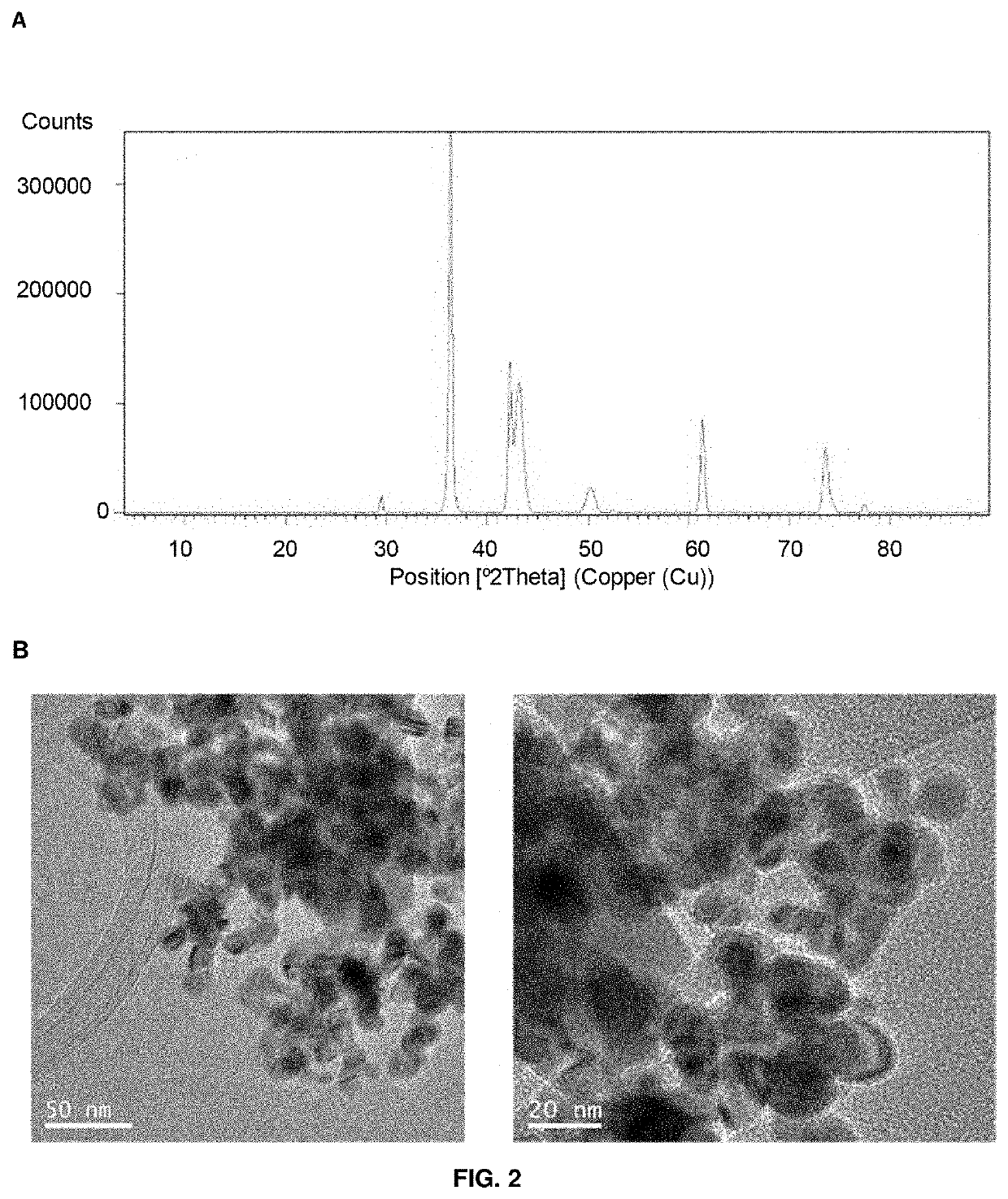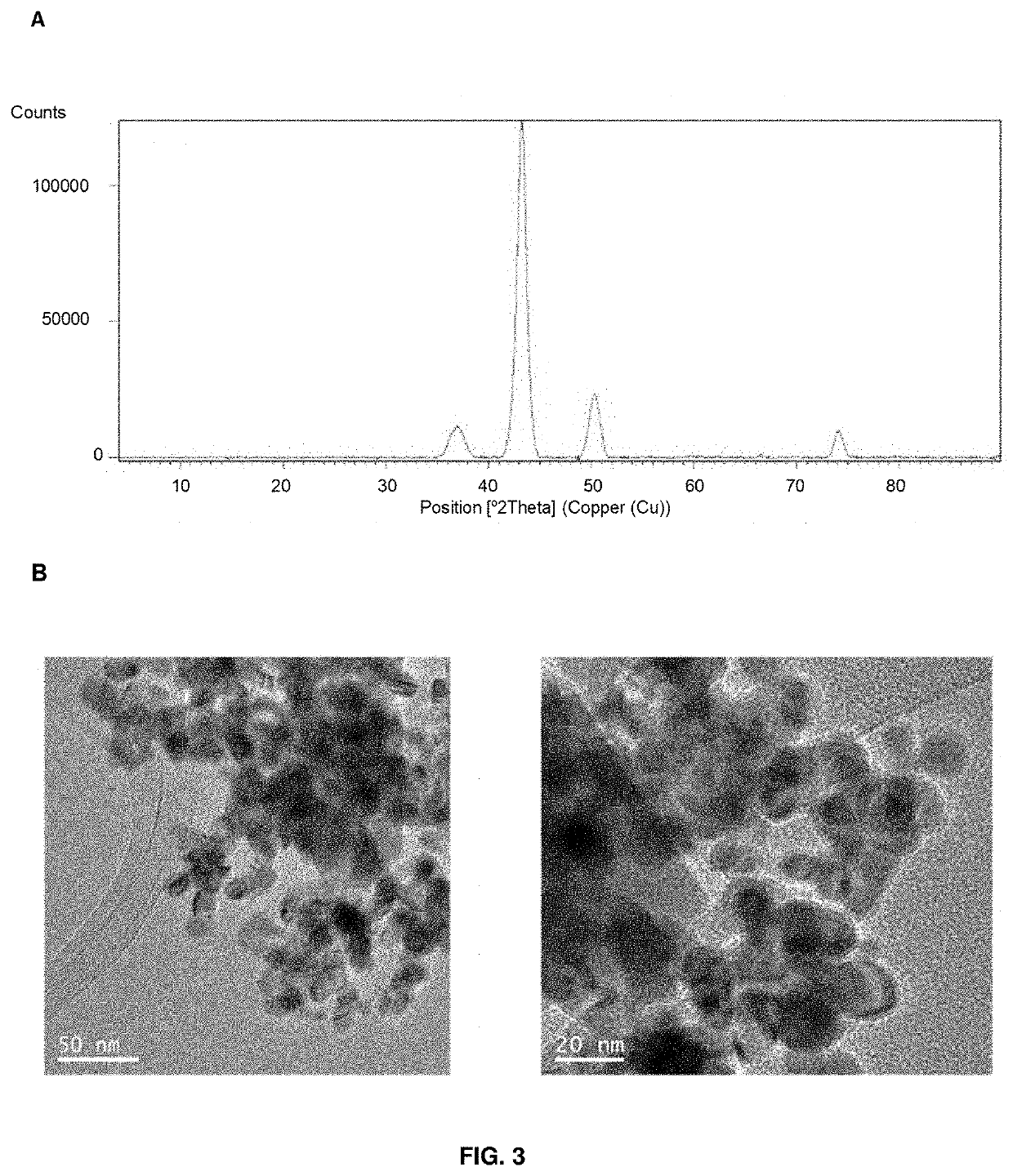Hybrid material comprising a protein matrix and copper nanoparticles therein, process for preparing the same and use thereof
a technology of protein matrix and copper nanoparticles, which is applied in the direction of organic compound/hydride/coordination complex catalyst, physical/chemical process catalyst, metal/metal-oxide/metal-hydroxide catalyst, etc., can solve the problems of limiting the use of cu nanoparticles and prone to oxidation
- Summary
- Abstract
- Description
- Claims
- Application Information
AI Technical Summary
Benefits of technology
Problems solved by technology
Method used
Image
Examples
example 1
ynthesis of Cu-CALB-BIC and Cu-CALB-PHOS Bionanohybrids
[0090]1.8 mL (18 mg protein) of commercial Candida antarctica lipase solution was added to 60 mL buffer 0.1M (sodium bicarbonate pH=10 or sodium phosphate pH 7) in a 250 mL glass bottle containing a small magnetic bar stirrer. Then, 600 mg of Cu2SO4×5H2O (10 mg / ml) was added to the protein solution and it was maintained for 16 hours. After the first 30 min incubation, the solution turned cloudy (turquoise) and the pH solution was measured indicating a decrease from 8 or 6 depending on the buffer used. After 16 h, 6 mL of NaBH4 (300 mg) aqueous solution (1.2 M) was added to the cloudy solution (in two times of 3 mL) obtaining a final concentration of 0.12 M of sodium borohydride in the mixture. The solution turned rapidly black and, the mixture was reduced during 30 min. After the incubation, in all cases, the mixture was centrifuged at 8000 rpm for 5 min, (10 mL per falcon type tube). The generated pellet was re-suspended in 15 ...
example 2
Reduction of 4-Nitrophenol (pNP) to 4-Aminophenol (pAP)
[0095]To an aqueous solution of p-nitrophenol (pNP) (1 mM; 2 mL), solid NaBH4 (3 mg) was added to reach a final concentration of 0.04 M (The typical catalytic reaction was performed by adding an excess of NaBH4 (0.04 M) to ensure its constant concentration throughout the reaction and, therefore, to apply a pseudo-first-order kinetic with respect to the pNP to an aqueous solution of the substrate in the presence of catalysts). In these conditions, upon the addiction of NaBH4, the initial absorbance band of the solution of pNP undergoes to an immediate shift from 317 to 400 nm due to the formation of 4-nitrophenolate ions. Immediately after that, 3 mg of the different Cu-CALB bionanohybrids were added under gentle stirring at 25° C. in an orbital shaker. The reaction progress was monitored by taking out an aliquot of the solution (0.1 mL) at different times, diluting it with distilled water (2 mL) and measuring the absorption spec...
example 3
Degradation of Bisphenol-A (BPA)
[0096]A solution of 10 mM of BPA in pure acetonitrile was prepared. 0.2 ml of this solution were dissolved in 10 mL of either 100 mM or 5 mM sodium phosphate buffer pH 6, pH 7 or pH 8 to achieve a 0.2 mM concentration of BPA. The solution pH was adjusted using HCl or NaOH 1 M. Hydrogen peroxide was added to this BPA solution to obtain different concentrations (12, 25, 50, 100 or 150 mM). To initialize the reaction, 3 mg of the nanohybrid was added to 2 mL of this solution (BPA and H2O2) in a 7 mL glass flask. Gentle stirring was provided at room temperature by a roller. Samples (30 μl) at different times were taken and the reaction was followed by HPLC. The samples were diluted 5 times in a mixture of distilled water / acetonitrile 50 / 50 before injection. The HPLC column was C8 Kromasil 150×4.6 mm AV-2059. The HPLC conditions used were: an isocratic mixture of 50% acetonitrile and 50% bi-distilled water, UV detection at 225 nm using a Diode array detect...
PUM
| Property | Measurement | Unit |
|---|---|---|
| Temperature | aaaaa | aaaaa |
| Temperature | aaaaa | aaaaa |
| Time | aaaaa | aaaaa |
Abstract
Description
Claims
Application Information
 Login to View More
Login to View More - R&D
- Intellectual Property
- Life Sciences
- Materials
- Tech Scout
- Unparalleled Data Quality
- Higher Quality Content
- 60% Fewer Hallucinations
Browse by: Latest US Patents, China's latest patents, Technical Efficacy Thesaurus, Application Domain, Technology Topic, Popular Technical Reports.
© 2025 PatSnap. All rights reserved.Legal|Privacy policy|Modern Slavery Act Transparency Statement|Sitemap|About US| Contact US: help@patsnap.com



